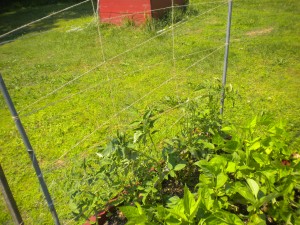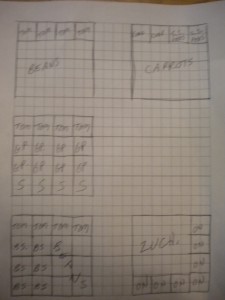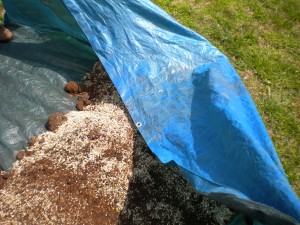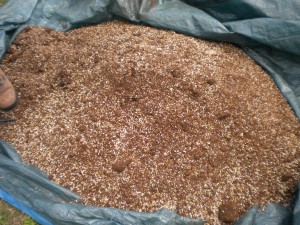
Today I thought I’d spend some time talking tomatoes. And trellising. There are three ways to manage tomato plants. Caging— putting a circular support around your tomatoes and allowing them to bush, staking— using a central stake to support your plant, and trellising— pruning them to vine up a trellis. We have always preffered trellising. Here’s why:
- Trellising allows you to plant your plants closer together, thus improving your yield.
- It allows you to reach and monitor the tomatoes better, as they are more visible.
- It transfers more of the plant’s nutrients to the tomatoes, rather than to leaves.
It is a bit more labor intensive. I have discussed earlier how to create a trellis frame for your garden. When you have it in place, you simply take a ball of twine or other light cord, tie it of near the base of one side of the frame,and draw it across to the base of the other side of the frame. Wrap it around once, then head back across at a slight angle. You should arrive back at the first side of the frame about 9-10 inches above your original knot. Wrap it around once again, then head back across. Repeat until you get to the top of the frame, then tie it off. You will need some vertical supports. I do two, each 1/3 of the way across. Tie off at the top of the frame, head down to the first horizontal string, then wrap your vertical string around it. head down to the next one and repeat. Do this until you reach the bottom, then tie off. Below you will see the wrapping technique, and the finished trellis.
You can then begin feeding your tomato (or cucumber or pea) plants up through the trellis. Now for the controversial part–pruning. Some are aghast at how radically I prune my tomato plants. But remember, you just need enough leaves for the creation of chlorophil. What your tomato plant really need to concentrate on is—wait for it–creating tomatoes! The leaves you want to remove are those that are especially large. My father used to call those “sucker leaves”. You want to remove them at the base, being careful not to remove any juncture which may produce a blossom or more vines. You can either pinch them off, or use scissors or pruning shears. I usually just pinch, because fingers are a tool you always carry with you. Below, you can see a before and after pruning moment.
Remember, you want to find a balance between pruning and leaving enough leaves for the continued health of your plant. In the future i will post pictures as they grow to demonstrate pruning. The red flashes you see in the pictures to the right are called tomato trays. You insert them at the base of your plants to help regulate the amount of water that gets to the roots. This helps to prevent blossom end rot, which we had some trouble with last year.
Well, that’s about it for this time!See you all next installment.












